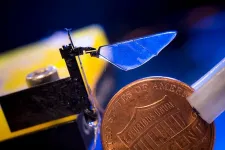(Press-News.org) Cancer immunotherapy drugs called PD-1 inhibitors are widely used to stimulate the immune system to fight cancer, but many patients either don’t respond or develop resistance to them. A new small-molecule drug candidate being tested in an early-stage clinical trial aims to improve patient responses to immunotherapy.
Now scientists have shown, in a study published today in Nature, that the small molecule works through two different mechanisms to slow tumor growth and increase survival in lab animals.
Researchers from the Tumor Immunotherapy Discovery Engine (TIDE) at the Broad Institute of MIT and Harvard, AbbVie, and Calico Life Sciences report that the molecule simultaneously makes tumors more sensitive to immune attack and boosts the activity of immune cells to fight tumors in mice.
The molecule works by blocking the PTPN2 and PTPN1 proteins, which normally act to shut down the ability of cells to sense signals that activate immune cells. The researchers found that by inhibiting PTPN2/N1, the molecule turns immune cells called T and NK cells into more effective killers of tumor cells and also makes tumor cells more vulnerable to attack. Blocking PTPN2/N1 also helps reduce T-cell exhaustion, a type of T-cell dysfunction that is thought to underlie some cancer immunotherapy resistance.
The molecule’s dual mechanism of action — targeting both tumor and immune cells — is unique compared to other cancer immunotherapies including PD-1 drugs, and the researchers think it could explain why the molecule was so effective on its own in animal models and may not even need to be used in combination with other drugs such as anti-PD-1 therapy.
AbbVie and Calico discovered the molecule, called ABBV-CLS-484, after TIDE researchers at Broad identified the PTPN2 gene as a promising cancer immunotherapy target in 2017. AbbVie and Calico are currently testing the molecule and another related molecule, also developed by AbbVie and Calico, in phase 1 clinical trials.
“This is an unprecedented opportunity to evaluate how immune responses work,” said Robert Manguso, who is co-senior author on the study, an associate member at the Broad, and an assistant professor at the Massachusetts General Hospital Center for Cancer Research and Harvard Medical School. “The ability to further explore this signaling pathway in clinical studies is really important.”
Manguso and Kathleen Yates at the Broad co-direct TIDE, which uses CRISPR screens and other tools in animals to systematically uncover genes such as PTPN2 that cancers use to evade immunotherapy. Hakimeh Ebrahimi-Nik, a senior research scientist in TIDE, and Christina Baumgartner, a senior principal research scientist at AbbVie, were co-first authors on the study. In addition to Manguso and Yates, Jennifer Frost, a research fellow at AbbVie, and Philip Kym, vice president of Global Medicinal Chemistry at AbbVie, co-led the study in collaboration with scientists at Calico.
“It still sort of stuns me that we went from discovering a target in 2017 to testing drugs in patients starting in 2020,” Yates said. “The ability to leverage these partnerships, resources, technology like CRISPR, and AbbVie’s medicinal chemistry — it’s just been this confluence of factors that has felt like a fast-forward button.”
“Discovering a mechanism that has the potential to make a difference in someone’s life is one of the most exciting and rewarding parts about being a drug discovery scientist,” Baumgartner said. “We work every day with a sense of urgency and dedication knowing that patients are waiting. By collaborating with our partners at Calico and the Broad, we were able to quickly discover, characterize, and develop these innovative molecules.”
“The challenge of identifying orally bioavailable small molecule therapeutics targeting the active site of a phosphatase drug class was significant. In fact, previous work across the pharmaceutical industry targeting active site phosphatase inhibitors was unsuccessful, leading to the general conclusion that this was an ‘undruggable’ target class,” added Kym. “Therefore, it was very exciting to see the collaborative work of the combined discovery team be successful in delivering this first-in-class clinical candidate.”
“This three-way collaboration among Calico, the Broad Institute, and AbbVie demonstrates the power of combining the best features of academia with the best of industry to accelerate scientific advances — in this case, translating early biology and target discovery into a clinical compound that is the first known active site phosphatase inhibitor of any kind,” said Marcia Paddock, co-author and director of oncology new target development at Calico.
Keeping cancer in check
In 2017, in an experiment that would become the foundation of TIDE, Manguso and researchers including W. Nicholas Haining (then at the Dana-Farber Cancer Institute and now at Arsenal Bio) systematically combed through almost 2,400 cancer genes in mice, looking for those that made melanoma tumors more or less sensitive to treatment with PD-1 inhibitors. They homed in on the PTPN2 gene and found that deleting it made tumor cells strikingly more sensitive to anti-PD-1 therapy.
But Manguso and Yates had another reason to be hopeful: PTPN2 is highly expressed in T cells, and previous research had shown that deleting it helped activate those cells, which could improve their ability to keep tumors in check. PTPN2 and a closely related gene called PTPN1 both encode phosphatases that inhibit signaling in an important immune pathway called JAK-STAT.
However, drug companies had historically struggled to make inhibitors that bind to the active site of these phosphatases because they have a strong electric charge. This means that drugs that bind to them must also be highly charged, making it difficult for them to cross the cell membrane and enter the cell.
“There was evidence in the literature that this was going to be very difficult, but AbbVie just tackled the problem in a pretty fearless way,” Manguso said. “That culture of optimism was really important for the project’s eventual success.”
AbbVie scientists succeeded in designing a small molecule that enters the cell and binds to the PTPN2 and PTPN1 phosphatases, and the team then tested the molecule in tumor-bearing mice. Animals treated with the molecule showed slower tumor growth and survived longer than untreated animals, suggesting that ABBV-CLS-484 may work on its own, unlike many other emerging immunotherapies. The team also found that mice treated with both the molecule and an anti-PD-1 drug showed an even greater benefit, suggesting that the molecule may work in combination with other immunotherapies in patients.
Orchestrating efficacy
Led by Ebrahimi-Nik at the Broad and Baumgartner at AbbVie, together with scientists at Calico, the researchers uncovered the mechanism of action that may explain why the drug is so potent in lab animals. They found that inhibiting PTPN2 and PTPN1 in tumor cells made the cells more susceptible to certain cell-killing signals produced by immune cells, and also made cancer-fighting NK and T cells more active in tumors in animals and in human blood samples.
Moreover, ABBV-CLS-484 appeared to reduce T-cell exhaustion. T cells treated with the molecule kept functioning and dividing, helping to control cancer growth even in settings where T cells typically struggle, such as in tumors that don’t have significant infiltration of immune cells, or that have spread elsewhere in the body. The researchers showed that ABBV-CLS-484 causes an increase in JAK-STAT signaling that may help keep T cells active and prevent their exhaustion. Ebrahimi-Nik says this strong effect on T cells hasn’t been observed in other immunotherapies, including anti-PD-1 drugs.
“When we treat animals with our inhibitor, we observe a specific cluster of CD8+ T cells in the tumor that are more active — they are more effective, more proliferative, and less exhausted,” she said. “We were really impressed by that.”
TIDE researchers are now working with scientists from AbbVie, Calico, and other teams to design a new phase of clinical trials and identify markers of patient response to ABBV-CLS-484.
“Removing the inhibition of JAK-STAT signaling in these T cells is making them extremely effective warriors at the frontline, and is also significantly reducing T-cell exhaustion,” Yates said. “To our knowledge, no one has observed that with a small molecule immunotherapy before. And we are incredibly excited to understand how this can improve responses in patients.”
Support for this research was provided in part by Calico Life Sciences.
Paper cited:
Baumgartner CK, Ebrahimi-Nik H, et al. PTPN2/N1 inhibitor ABBV-CLS-484 unleashes potent anti-tumor immunity. Nature. Online October 4, 2023. DOI: 10.1038/s41586-023-06575-7.
Written by By Allessandra DiCorato
About Broad Institute of MIT and Harvard
Broad Institute of MIT and Harvard was launched in 2004 to empower this generation of creative scientists to transform medicine. The Broad Institute seeks to describe the molecular components of life and their connections; discover the molecular basis of major human diseases; develop effective new approaches to diagnostics and therapeutics; and disseminate discoveries, tools, methods and data openly to the entire scientific community.
Founded by MIT, Harvard, Harvard-affiliated hospitals, and the visionary Los Angeles philanthropists Eli and Edythe L. Broad, the Broad Institute includes faculty, professional staff and students from throughout the MIT and Harvard biomedical research communities and beyond, with collaborations spanning over a hundred private and public institutions in more than 40 countries worldwide.
END
Cancer immunotherapy candidate provokes powerful dual response in cancer and immune cells
The small molecule, now in clinical trials, increases activity of immune cells and sensitivity of tumors to immune attack
2023-10-04
ELSE PRESS RELEASES FROM THIS DATE:
Research shows strong link between ADHD and car crashes in older adult drivers
2023-10-04
In a study on the prevalence of attention-deficit/hyperactivity disorder (ADHD) and its association with crash risk among older adult drivers, researchers at Columbia University Mailman School of Public Health found that older adult drivers with ADHD are at a significantly elevated crash risk compared with their counterparts without ADHD. Outcomes included hard- braking events, and self-reported traffic ticket events, and vehicular crashes. Until now research on ADHD and driving safety was largely limited to ...
Pediatric RSV-associated hospitalizations before and during the pandemic
2023-10-04
About The Study: This study found that the burden of respiratory syncytial virus (RSV)-associated hospitalizations in Canadian pediatric hospitals was substantial, particularly among infants less than six months of age, and RSV hospitalizations increased in 2021-2022 compared with the pre-pandemic period, while severity of illness remained similar. These findings suggest that RSV preventive strategies for infants less than six months of age would be associated with decreased RSV disease burden in children.
Authors: Jesse Papenburg, ...
Prevalence, trends in diagnosed ADHD among children and adolescents
2023-10-04
About The Study: Based on U.S. national representative data, the estimated attention-deficit hyperactivity disorder (ADHD) prevalence was 10.08% to 10.47% among children and adolescents ages 4 to 17 from 2017 to 2022, which was similar to the prevalence from the National Health Interview Survey in 2015 to 2016 (10.20%). No significant annual change in the prevalence of ADHD was found from 2017 to 2022. Notably, the estimated prevalence of ADHD among individuals in the U.S. in this study was higher than worldwide estimates (5.3%) in earlier years (1978-2005).
Authors: Wenhan Yang, M.D., Ph.D., of Guangdong ...
Effectiveness, safety of enteric-coated vs uncoated aspirin in patients with cardiovascular disease
2023-10-04
About The Study: In this post hoc secondary analysis of 10,678 participants with atherosclerotic cardiovascular disease from a randomized clinical trial, enteric-coated aspirin was not associated with significantly higher risk of heart attack, stroke, or death or with lower bleeding risk compared with uncoated aspirin, regardless of dose, although a reduction in bleeding with enteric-coated aspirin cannot be excluded. More research is needed to confirm whether enteric-coated aspirin formulations or newer formulations will improve outcomes in this population.
Authors: Mark B. Effron, M.D., of the University of Queensland-Ochsner Clinical School in New Orleans, is the corresponding ...
These robots helped understand how insects evolved two distinct strategies of flight
2023-10-04
Robots built by engineers at the University of California San Diego helped achieve a major breakthrough in understanding how insect flight evolved, described in the Oct. 4, 2023 issue of the journal Nature. The study is a result of a six-year long collaboration between roboticists at UC San Diego and biophysicists at the Georgia Institute of Technology.
The findings focus on how the two different modes of flight evolved in insects. Most insects use their brains to activate their flight muscles each wingstroke, just like we activate the muscles in our legs ...
New research finds that ancient carbon in rocks releases as much carbon dioxide as the world's volcanoes
2023-10-04
Main points:
New research has overturned the traditional view that natural rock weathering acts as a CO2 sink that removes CO2 from the atmosphere. Instead, this can also act as a large CO2 source, rivalling that of volcanoes.
The results have important implications for modelling climate change scenarios but at the moment, CO2 release from rock weathering is not captured in climate modelling.
Future work will focus on whether human activities may be increasing CO2 release from rock weathering, and how this could be managed.
A new study led by the University of Oxford has overturned the view ...
New "Assembly Theory" unifies physics and biology to explain evolution and complexity
2023-10-04
An international team of researchers has developed a new theoretical framework that bridges physics and biology to provide a unified approach for understanding how complexity and evolution emerge in nature. This new work on "Assembly Theory," published today in Nature, represents a major advance in our fundamental comprehension of biological evolution and how it is governed by the physical laws of the universe.
This research builds on the team's previous work developing Assembly Theory as an empirically validated approach to life detection, ...
Unlocking the secrets of neuronal function: a universal workflow
2023-10-04
Biophysically detailed neuronal models provide a unique window into the workings of individual neurons. They enable researchers to manipulate neuronal properties systematically and reversibly, something that is often impossible in real-world experiments. These in silico models have played a pivotal role in advancing our understanding of how neuronal morphology influences excitability and how specific ion currents contribute to cell function. Additionally, they have been instrumental in building neuronal circuits to simulate and study brain activity, offering ...
Munich neuroscientist receives around 1.5 million euros for research into ALS and FTD
2023-10-04
Dr. Qihui Zhou, a neuroscientist at DZNE’s Munich site, has been awarded a “Starting Grant” from the European Research Council (ERC) worth about 1.5 million euros to investigate disease mechanisms of amyotrophic lateral sclerosis (ALS) and frontotemporal dementia (FTD). With her studies, which will focus on the role of immune cells in the disease process and on the most common genetic forms of ALS and FTD, Zhou aims to pave the way for better treatments.
ALS and FTD are devastating diseases characterized by loss of brain cells for which there ...
INSEAD launches world’s largest XR immersive learning library for management education and research
2023-10-04
First business school to launch comprehensive library of VR Learning Experiences to make management education more impactful and to advance management research
VR Learning Experiences already used by 40+ professors and 13K+ learners at INSEAD and now available globally via the INSEAD XR Portal
Professor Ithai Stern, Academic Director of the INSEAD Immersive Learning Initiative, wins 2023 Strategic Management Society Educational Impact Award for his contribution to quality and innovation of strategic management teaching
Fontainebleau ...
LAST 30 PRESS RELEASES:
Numbers in our sights affect how we perceive space
SIMJ announces global collaborative book project in commemoration of its 75th anniversary
Air pollution exposure and birth weight
Obstructive sleep apnea risk and mental health conditions among older adults
How talking slows eye movements behind the wheel
The Ceramic Society of Japan’s Oxoate Ceramics Research Association launches new international book project
Heart-brain connection: international study reveals the role of the vagus nerve in keeping the heart young
Researchers identify Rb1 as a predictive biomarker for a new therapeutic strategy in some breast cancers
Survey reveals ethical gaps slowing AI adoption in pediatric surgery
Stimulant ADHD medications work differently than thought
AI overestimates how smart people are, according to HSE economists
HSE researchers create genome-wide map of quadruplexes
Scientists boost cell "powerhouses" to burn more calories
Automatic label checking: The missing step in making reliable medical AI
Low daily alcohol intake linked to 50% heightened mouth cancer risk in India
American Meteorological Society announces Rick Spinrad as 2026 President-Elect
Biomass-based carbon capture spotlighted in newly released global climate webinar recording
Illuminating invisible nano pollutants: advanced bioimaging tracks the full journey of emerging nanoscale contaminants in living systems
How does age affect recovery from spinal cord injury?
Novel AI tool offers prognosis for patients with head and neck cancer
Fathers’ microplastic exposure tied to their children’s metabolic problems
Research validates laboratory model for studying high-grade serous ovarian cancer
SIR 2026 delivers transformative breakthroughs in minimally invasive medicine to improve patient care
Stem Cell Reports most downloaded papers of 2025 highlight the breadth and impact of stem cell research
Oxford-led study estimates NHS spends around 3% of its primary and secondary care budget on the health impacts of heat and cold in England
A researcher’s long quest leads to a smart composite breakthrough
Urban wild bees act as “microbial sensors” of city health.
New study finds where you live affects recovery after a hip fracture
Forecasting the impact of fully automated vehicle adoption on US road traffic injuries
Alcohol-related hospitalizations from 2016 to 2022
[Press-News.org] Cancer immunotherapy candidate provokes powerful dual response in cancer and immune cellsThe small molecule, now in clinical trials, increases activity of immune cells and sensitivity of tumors to immune attack




